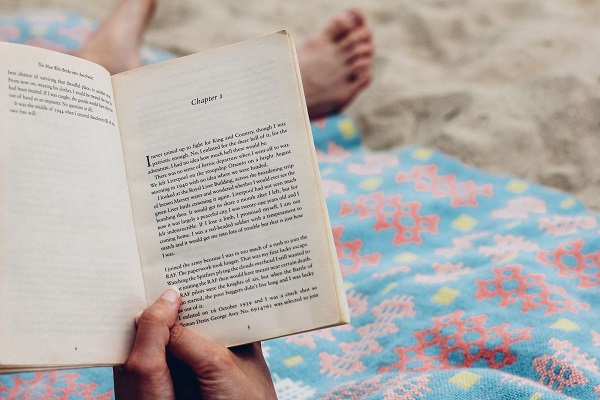There are millions of things going on these days that divert our attention from what matters. Scrambling to reply to that email… Hitting ‘play’ on the next episode of your latest binge watch…
It’s no surprise that our attention spans have shortened to compensate as we’ve grown accustomed to juggling various tasks at once.
This can create a particular challenge for writers. Why? Well, we have to focus on not only attracting and hooking our reader’s interest from the start, but also on keeping it for an extended duration.
So how do we ensure that our readers’ eyes are glued to the pages, not even looking up for a text message or a hurricane?
Your first page needs to deliver.
In today’s post, we’ll analyse how to write an opening scene that sucks your readers into your story – and how to avoid the opposite effect.
Let’s start with what not to do…
What NOT To Include In Your First Scene
A character waking up/looking in the mirror
Open on a bright, jolly character mid-yawn, stretching their arms over their head. They draw back their fluffy blanket, slip out of bed and saunter to the window.
They peel back the curtain to admire the lovely, sunny day, proceeding to – shocker – stroll to their vanity mirror, brush aside brown, chin-length hair…
Cut.
This is the kind of opening scene you don’t want in your novel.
Not only will it make your reader cringe, they’ll likely toss the book aside in favour of that cinnamon roll they’ve been eyeing all morning.
Opening with a character waking up and staring at themselves in the mirror is an old, clichéd method for the writer to introduce and describe a character.
Readers don’t like it, and you should avoid it – particularly on your first page.
Remember that how much (or little) you choose to reveal about your character’s appearance is your decision. But if you do need to describe a character, one way to successfully pull this off is by using another character’s viewpoint of them.
You can do this if you’re writing a novel with multiple POVs, or through various character interactions.
For example, let’s say the protagonist, Olivia, has funky pink hair and tattoos. You could show Olivia’s mother eyeing her appearance with a furrowed brow while insisting that she changes her hair once and for all.
A dream sequence
The obvious downside of opening your novel with a dream sequence is that you’re essentially introducing your reader to a fake world.
They may become invested in this world, only for it to be yanked from them as the ‘real’ story begins.
This can lead to readers feeling disconcerted or cheated – not a great way to start things off.
Introducing too many characters at once
We understand. You’re excited for your reader to meet your cast – but keep in mind that introducing too many characters right at the start can be overwhelming.
For now, focus on showcasing your protagonist in the spotlight. Then, begin introducing one or two other characters at a time.

This brings us to what you should include in your first scene…
6 Ways To Hook The Reader From Page One
1. Introduce The Protagonist
After you provide the catchy hook (the first lines of Chapter One that lure the reader in), it’s time to focus on introducing your protagonist to your reader.
It’s important to present your protagonist in as fascinating, alluring or sympathetic a manner as possible, so that the reader cares enough to read on.
This can be accomplished during a characteristic moment – but we’ll talk more about that below.
In the meantime, here’s how to ensure the meeting between your character and reader is a successful and memorable one…
Describe them
Once you get a good visual of your character, you can pass it on to your readers. It will help them picture the character, and might also give a little insight into their personality.
For example: does your protagonist dress in high stilettos, or does she prefer a messy bun, a holey t-shirt and pajama shorts with dancing pink llamas?
Show their unique attributes
Your character should have traits, characteristics and idiosyncrasies that are both obvious and subtle.
Give readers an insight into the kind of person they are by weaving some of their defining attributes through your opening scene.
Show them in their natural habitat or communicating with another character
How characters interact in their natural world and with other characters gives us a general idea of who they are.
Using this option also allows you to introduce more than one character at once (though as we mentioned above, don’t go overboard with this).
2. Open With Conflict/Characteristic Moment
The characteristic moment is your reader’s first impression of your character. It defines who your character is, begins their arc, and foreshadows the story’s conflict.
Conflict is the main driver of most narratives, so it’s also a good thing to introduce early. And yes, this can be done in the very first scene!
First, ask yourself these questions:
- At the story’s opening, what issues is my character facing?
- What internal struggle are they about to embark on?
- What does my character want (externally) and how does this prelude what they truly need (internally)?
A good way to open a story is to demonstrate what your character is lacking. Are they lonely? Are they a struggling songwriter with bills cascading from the coffee table to the dirty, dusty carpet?
Maybe their conflict stems from an unsatisfying relationship that is going nowhere, but they don’t know how to move on without that other person.
Your reader should witness the struggle your character faces as they desire something they can’t have at first (goal) because there is something preventing them (obstacle).
This is a great way to set up your character’s internal and external struggle, as well as foreshadowing future conflict.
With that being said, your opening scene doesn’t necessarily need to include the inciting incident. But if your inciting incident occurs later on, make sure it’s before the 10% mark of the first act.

3. Tease Readers with Open-Ended Questions
What is going on with this character?
Why does she seem so sad?
Why was she staring at that guy like she wanted to kill him?
Prompting open-ended questions in your first scene can ensure readers keep turning pages to get to the answers.
Open-ended questions drive your story forward from the first page, with the suggestion that they will all be answered later.
But if the questions are not engaging enough, the reader will not be invested. And if you include too many, you will only confuse, frustrate and overwhelm your reader.
Keep it balanced, and remember that open-ended questions tend to work best if your reader is invested in the character/s that the questions revolve around.
4. Start In Medias Res
‘In media res‘ is Latin for ‘in the middle of things’. Sure, we’ve all heard this term, but how can we successfully apply it to our novels?
Beginning a novel in medias res can be an effective way to start with a bang and introduce the reader to the upcoming conflict.
It doesn’t necessarily have to show the main conflict, but should give your readers a taste of what is to come. And naturally, it should make them curious about the events that have led the character to this moment in the story.
For example, you can show your character bouncing on their toes in excitement (what are they excited about?) or bawling their eyes out (what has made them sad?).
Or, you can show them tumbling over trash cans, feet slapping the wet pavement while fleeing from bad guys (who’s chasing them, and why? What will it mean if they’re caught?).
When using this technique to open your novel, you must do so in a way that is vital to the main story/conflict.
For example, don’t start in the middle of a relationship breakup if it has nothing to do with the story’s central plot. On the other hand, if the plot is centered on the scorned lover coming back for revenge, then this is perfectly acceptable.
5. Introduce Other Main Characters
Main characters other than your protagonist are an integral part of your story, and of your protagonist’s inner/external journey. For this reason, it’s a good idea to introduce them early.
These characters are going to take up a large chunk of your story, and as such, require proper development and ‘screen time’ so your reader can get to know them.
With that being said, don’t feel as though it is necessary to introduce every single character in your book right away. You can sprinkle characters here and there, weaving them into your story at a good pace.
The types of characters you choose to include in your first scene is totally up to you! You can introduce the antagonist, supporting characters or minor characters, as long as it makes sense to your story.
Try including at least one additional character in your first scene with your protagonist, giving readers the chance to learn a bit more about how the protagonist interacts with others.
It’s also the perfect way to incorporate the ‘show, don’t tell’ method into your writing. As the characters exchange dialogue, we can show certain things without simply stating them in the narrative.

6. Choose The Perfect Ending For The First Scene
With all of this talk on how to start an opening scene, we thought it would be fitting to talk about how to end it as well.
The ending of your first scene must be teasing enough so that it prompts the reader to flip to the next scene, the next chapter, and so on.
Has the setting changed? Has a new character arrived? Has the protagonist done something surprising that will make readers interested to see what will happen next?
Ending your chapter with a bang can introduce a chain of events and thus truly begin your story. Think of the first scene as the first domino leaning forward, toppling into the next.
Then that domino plunges forward, hitting the next domino until the entire line begins toppling over, gaining momentum and slamming into one another until the end.
This is how you want your scenes to move: one after the other, so that the reader can’t fathom anything other than finishing your book!
***
So, there you have it! Now that you’re equipped with the proper tools to write a killer first page, you have the recipe that will hook your readers in for the long haul.
Crafting a story takes dedication and a lot of hard work, but if you’ve got a solid opening, you’re on the right track.
Write on, word slayers!